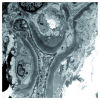C3 glomerulopathy
- PMID: 28357053
- PMCID: PMC5357035
- DOI: 10.12688/f1000research.10364.1
C3 glomerulopathy
Abstract
C3 glomerulopathy is a recently defined entity that encompasses a group of kidney diseases caused by abnormal control of complement activation with deposition of complement component C3 in glomeruli leading to variable glomerular inflammation. Before the recognition of the unique pathogenesis of these cases, they were variably classified according to their morphological features. C3 glomerulopathy accounts for roughly 1% of all renal biopsies. Clear definition of this entity has allowed a better understanding of its pathogenesis and clinical course and is likely to lead to the design of rational therapies over the next few years.
Keywords: C3 complement; glomerular inflammation; renal pathology.
Conflict of interest statement
Competing interests: The author declares that he has consulting agreements with Alexion Pharmaceuticals and Achillion Pharmaceuticals.Competing interests: J.D.L is an inventor of patents and patent application describing complement inhibitors and their clinical use. He is also the founder of Amyndas Pharmaceuticals, which is developing complement inhibitors for therapeutic purposes.No competing interests were disclosed.No competing interests were disclosed.No competing interests were disclosed.No competing interests were disclosed.
Figures




References
Publication types
LinkOut - more resources
Full Text Sources
Other Literature Sources
Miscellaneous

